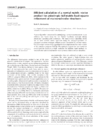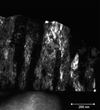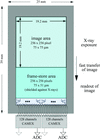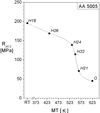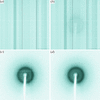issue contents
December 2009 issue

Cover illustration: Three-dimensional reconstructed crystal (purple), loop (yellow) and solvent (transparent pink) for a native DNA sample. Courtesy of Brockhauser, Di Michiel, McGeehan, McCarthy & Ravelli [J. Appl. Cryst. (2008), 41, 1057-1066].
research papers
The difference in thermal expansion of the two primary phases, γ and γ′, causes the scattering contrast to change with temperature in Ni superalloys. This feature can be used for determination of the scattering contrast without a knowledge of the compositions of the individual phases.
A high-resolution and high-throughput synchrotron powder diffractometer has been automated for use with samples that are mailed in by Advanced Photon Source users.
The effect of anomalous transmission of X-rays on ZnGeP2 crystals has been investigated, using the method of X-ray topography based on the Borrmann effect. The identification of the defects revealed in ZnGeP2 was carried out by comparison of the experimental intensity contrast with simulated images of the defects.
The standing X-ray wavefield intensity of a single crystal, under dynamical diffraction conditions, is directly measured by setting a 50 µm-thick single-crystal CCD detector chip in nondispersive back-diffraction geometry.
Kirkpatrick–Baez neutron supermirrors can efficiently focus polychromatic neutron beams to micrometre dimensions. Early results from such a system installed on the Spallation Neutrons at Pressure Beamline 3 at the Spallation Neutron Source at Oak Ridge National Laboratory are presented.
The nuclear and magnetic scattering contributions in small-angle scattering experiments on a diluted water-based magnetic fluid are separated by the contrast variation technique and scattering of polarized neutrons. The significant difference found in the nuclear and magnetic apparent particle sizes is related to different nuclear and magnetic correlation lengths in the system.
A new set of equations for a normal matrix–vector product for the case of anisotropic refinement is given. Significantly faster methods for the calculation of a preconditioner and the normal matrix–vector product are described in detail.
Various aspects of the application of the Scherrer formula to grain-size analysis in thin films of soft materials are discussed within the methodology of grazing-incidence small- and wide-angle scattering and in conjunction with the use of area detectors.
Open  access
access
 access
accessMORPHEUS is an initial protein crystallization screen with a unique organization which integrates components and ligands selected after analysing all crystal structure data deposited with the Protein Data Bank and local data gathered at the MRC Laboratory of Molecular Biology, Cambridge, England (MRC-LMB). Three challenging proteins from the MRC-LMB have already been crystallized exclusively using MORPHEUS.
The formalism for and the parameterizations of aspherical electron scattering factors using relativistic wavefunctions are presented.
Download citation


Download citation


The crystal structure of perdeuterated methanol monoammoniate, CD3OD·ND3, has been solved from neutron powder diffraction data collected at 4.2 and 180 K.
The matrix method for diffuse scattering has been effectively used to simulate the X-ray powder diffraction pattern of randomly restacked Ca2Nb3O10 nanosheets connected by K ions.
Basal plane bending was observed by synchrotron white-beam X-ray topography. The shapes of Laue spots for different reflections were simulated based on a spherical curvature model, and the simulation results fit well with the experimental images.
In situ tensile tests on polycrystalline Au thin films have been carried out under synchrotron radiation. The 2θ shift of diffraction lines, which reflects the elastic strain (and its heterogeneity) within the specimen, is analysed by means of several micromechanical approaches.
Structural characterization of nanocrystalline Mn-substituted ZnO has been carried out using X-ray diffraction, high-resolution transmission electron microscopy and small-angle neutron scattering in order to check the growth of secondary phases, particle size and size distribution which are the prime issues for analyzing different physical properties.
The slight tetragonality of only about 2% in ordered γ-TiAl makes it difficult to discriminate the order variants in orientation mapping by electron backscatter diffraction. A successful approach, based on high-accuracy measurement and a newly developed indexing scheme, is presented and validated.
Stress factors and residual stress in a film are simultaneously measured by in-situ X-ray diffraction during four-point bending. The procedure, here applied to a galvanic nickel coating, can be used for virtually any polycrystalline layer, without previous knowledge of single-crystal elastic constants or grain interaction models.
Download citation


Download citation


It is shown that the charge density of a molecule in a crystal can be obtained from normal-resolution data when thermal motion and electron density are de-convoluted. This can be achieved by incorporating fixed atomic displacement parameters from a preceding invariom refinement.
This study reports on the characterization of a carbon nanotube fibre using synchrotron radiation microbeam small- and wide-angle X-ray scattering in combination with microfluorescence.
A grating-based holographic X-ray diffraction technique has been developed which allows reconstruction of the density profiles of confined nano-scale fluids.
The crystallographic unit cell of γ-LiAlO2 is determined without a priori information by means of an energy-dispersive X-ray Laue diffraction experiment using a frame-store pn-junction CCD detector.
The potential of electron backscatter diffraction (EBSD) to determine integral macrotexture data is explored by comparing EBSD-derived textures with standard X-ray textures for the Al–Mg alloy AA 5005 in the cold-rolled and various back-annealed states. In particular, the effect of EBSD filtering tools and the impact of sampling step size on the statistical significance of EBSD data are investigated.
A method of using X-ray absorption spectroscopy together with resolved grazing-incidence geometry for depth profiling of atomic, electronic or chemical local structures in thin films is presented. Surface oxidation and local structural depth profiles in nanometric FePt films are determined, exemplifying the application of the method.
Open  access
access
 access
accessA shutterless continuous rotation method using an X-ray complementary metal-oxide semiconductor (CMOS) detector has been developed for high-speed, precise data collection in protein crystallography. The new method and detector were applied to the structure determination of three proteins by multi- and single-wavelength anomalous diffraction phasing and have thereby been proved to be applicable in protein crystallography.
Download citation


Download citation


This work presents an investigation of nondeuterated gypsum using the current generation of constant-wavelength neutron powder diffraction instruments at the Institut Laue–Langevin.
computer programs
PeckCryst has been developed and released for molecular crystal structure determination from powder diffraction data and uses a particle swarm optimization algorithm. The distributed releases can run on Windows and Linux (32- and 64-bit) platforms.
A computer program has been written to carry out factor group analysis of normal modes of vibration for crystal structures.
Ab initio crystal structure solution by powder diffraction data can be performed by EXPO2009 both in direct and in reciprocal space. The main applications and novel features of EXPO2009 are described.
laboratory notes
This article proposes an alternative approach to indexing X-ray Laue back-photographs with the emphasis on imperfect metallic single crystals.
A model of an air-cooled test tube (`crystallization socket-outlet adaptor') in a laboratory furnace, for simultaneous regulation of different crystallization parameters in crucible columns, is presented. This design enables fast studies of crystal growth.
Cheap model robots can be used to automate simple sample changing for less than the cost of a linear drive with far more flexibility of design.


 journal menu
journal menu















